数据采集与融合技术实践作业2_102302107_林诗樾
作业①:
–要求:在中国气象网(http://www.weather.com.cn)给定城市集的7日天气预报,并保存在数据库。
–输出信息:
Gitee文件夹链接
1)实验代码和运行结果
import requests
from bs4 import BeautifulSoup
import pandas as pd
import sqlite3
from datetime import datetime
import tabulate
def init_weather_database():
conn = sqlite3.connect("weather.db")
cursor = conn.cursor()
cursor.execute('''
CREATE TABLE IF NOT EXISTS weather (
id INTEGER PRIMARY KEY AUTOINCREMENT,
area TEXT NOT NULL,
date TEXT NOT NULL,
weather_info TEXT NOT NULL,
temperature TEXT NOT NULL,
crawl_time TIMESTAMP NOT NULL DEFAULT CURRENT_TIMESTAMP
)
''')
conn.commit()
return conn
def get_weather_html(url):
headers = {
"User-Agent": "Mozilla/5.0 (Windows NT 10.0; Win64; x64) AppleWebKit/537.36 (KHTML, like Gecko) Chrome/120.0.0.0 Safari/537.36",
"Referer": "http://www.weather.com.cn/"
}
try:
response = requests.get(url, headers=headers, timeout=10)
response.raise_for_status()
response.encoding = 'utf-8'
return response.text
except Exception as e:
print(f"获取页面失败:{str(e)}")
return ""
def parse_weather_data(html, area):
weather_list = []
soup = BeautifulSoup(html, "html.parser")
# 根据中国天气网的实际结构解析
forecast_container = soup.find("div", class_="tqtongji1")
if not forecast_container:
forecast_container = soup.find("ul", class_="t clearfix")
if not forecast_container:
print(f"未找到{area}的天气预报容器,尝试其他选择器")
# 尝试其他可能的选择器
forecast_container = soup.find("div", id="7d")
if not forecast_container:
return weather_list
day_items = forecast_container.find_all("li")[
:7] if forecast_container.name == "ul" else forecast_container.find_all("div", class_="tqtongji2")[:7]
for idx, item in enumerate(day_items, 1):
try:
# 尝试多种日期选择器
date_elem = item.find("h1") or item.find("div", class_="tqtongji21") or item.find("span")
date = date_elem.text.strip() if date_elem else f"第{idx}天"
# 天气信息选择器
weather_elem = item.find("p", class_="wea") or item.find("div", class_="tqtongji22")
weather_info = weather_elem.text.strip() if weather_elem else "未知天气"
# 温度选择器
temp_elem = item.find("p", class_="tem") or item.find("div", class_="tqtongji23")
temperature = temp_elem.text.strip() if temp_elem else "未知温度"
weather_list.append({
"序号": idx,
"地区": area,
"日期": date,
"天气信息": weather_info,
"温度": temperature
})
except Exception as e:
print(f"解析第{idx}天数据时出错:{str(e)}")
continue
return weather_list
def save_weather_to_db(conn, weather_data):
cursor = conn.cursor()
try:
for data in weather_data:
cursor.execute('''
SELECT id FROM weather WHERE area = ? AND date = ?
''', (data["地区"], data["日期"]))
if not cursor.fetchone():
cursor.execute('''
INSERT INTO weather (area, date, weather_info, temperature)
VALUES (?, ?, ?, ?)
''', (data["地区"], data["日期"], data["天气信息"], data["温度"]))
conn.commit()
print(f"成功保存{len(weather_data)}条数据到数据库")
except Exception as e:
conn.rollback()
print(f"数据插入失败:{str(e)}")
def main_weather_crawl():
# 使用真实的中国天气网URL
target_cities = {
"北京": "101010100",
"上海": "101020100",
"广州": "101280101"
}
conn = init_weather_database()
all_weather_data = []
for city_name, city_id in target_cities.items():
# 使用真实的中国天气网URL格式
weather_url = f"http://www.weather.com.cn/weather/{city_id}.shtml"
print(f"开始爬取{city_name}天气:{weather_url}")
html = get_weather_html(weather_url)
if not html:
print(f"获取{city_name}页面失败,跳过")
continue
weather_data = parse_weather_data(html, city_name)
if not weather_data:
print(f"解析{city_name}天气数据失败,跳过")
continue
all_weather_data.extend(weather_data)
save_weather_to_db(conn, weather_data)
print(f"{city_name}数据存储完成!获取到{len(weather_data)}天数据\n")
conn.close()
if all_weather_data:
# 生成Excel表格
df = pd.DataFrame(all_weather_data)
df.to_excel("weather_data.xlsx", index=False)
print("天气数据表格已保存至 weather_data.xlsx")
# 终端打印表格
headers = ["序号", "地区", "日期", "天气信息", "温度"]
table_data = [list(data.values()) for data in all_weather_data]
print(tabulate.tabulate(table_data, headers=headers, tablefmt="grid"))
print(f"\n总共爬取到{len(all_weather_data)}条天气数据")
else:
print("未能获取到任何天气数据,请检查网络连接或网站结构")
if __name__ == "__main__":
main_weather_crawl()
运行结果:

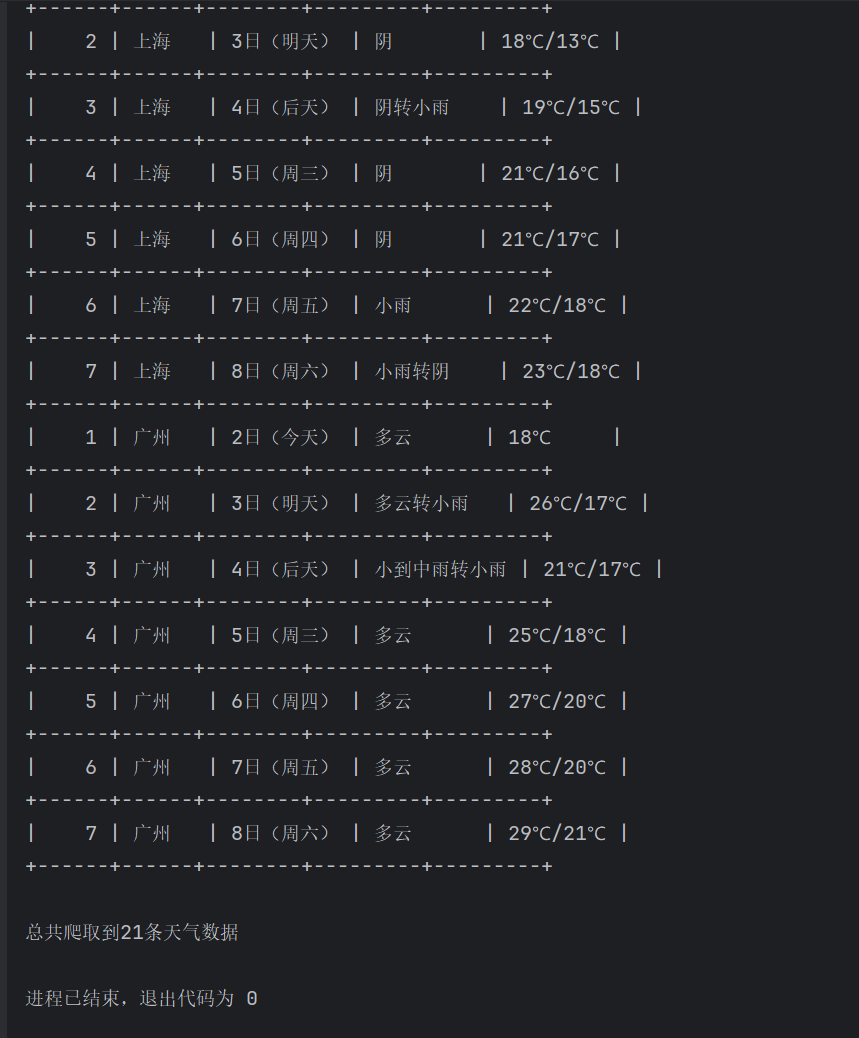

2)心得体会:天气爬虫项目的核心心得是:工业级爬虫开发的关键在于用多重防御策略(模拟浏览器、动态编码检测、多路解析备选)来应对真实网络环境中的各种不确定性,确保程序在网站结构变化、网络波动等复杂场景下仍能稳定运行。
作业②
–要求:用requests和BeautifulSoup库方法定向爬取股票相关信息,并存储在数据库中。
–候选网站:东方财富网:https://www.eastmoney.com/
新浪股票:http://finance.sina.com.cn/stock/
–技巧:在谷歌浏览器中进入F12调试模式进行抓包,查找股票列表加载使用的url,并分析api返回的值,并根据所要求的参数可适当更改api的请求参数。根据URL可观察请求的参数f1、f2可获取不同的数值,根据情况可删减请求的参数。
参考链接:https://zhuanlan.zhihu.com/p/50099084
1)实验代码
import requests
import json
import sqlite3
import time
from datetime import datetime
class StockSpider:
def __init__(self):
self.headers = {
'User-Agent': 'Mozilla/5.0 (Windows NT 10.0; Win64; x64) AppleWebKit/537.36',
'Referer': 'http://quote.eastmoney.com/'
}
self.base_url = "http://push2.eastmoney.com/api/qt/clist/get"
def get_stock_params(self, page=1):
"""构造请求参数"""
params = {
'cb': 'jQuery112406995981980579432_1625123456789',
'pn': page,
'pz': 20, # 每页数量
'po': 1,
'np': 1,
'ut': 'bd1d9ddb04089700cf9c27f6f7426281',
'fltt': 2,
'invt': 2,
'fid': 'f3',
'fs': 'm:0 t:6,m:0 t:80,m:1 t:2,m:1 t:23',
'fields': 'f1,f2,f3,f4,f5,f6,f7,f8,f9,f10,f12,f13,f14,f15,f16,f17,f18,f20,f21,f23,f24,f25,f22,f11,f62,f128,f136,f115,f152',
'_': str(int(time.time() * 1000))
}
return params
def parse_stock_data(self, data):
"""解析股票数据"""
stocks = []
if data and 'diff' in data:
for item in data['diff']:
stock = {
'code': item.get('f12', ''), # 股票代码
'name': item.get('f14', ''), # 股票名称
'current_price': item.get('f2', 0), # 当前价格
'change_amount': item.get('f4', 0), # 涨跌额
'change_rate': item.get('f3', 0), # 涨跌幅
'volume': item.get('f5', 0), # 成交量(手)
'turnover': item.get('f6', 0), # 成交额
'amplitude': item.get('f7', 0), # 振幅
'high_price': item.get('f15', 0), # 最高价
'low_price': item.get('f16', 0), # 最低价
'open_price': item.get('f17', 0), # 开盘价
'close_price': item.get('f18', 0), # 昨收价
'pe_ratio': item.get('f9', 0), # 市盈率
'pb_ratio': item.get('f23', 0), # 市净率
'total_market_cap': item.get('f20', 0), # 总市值
'circulating_market_cap': item.get('f21', 0), # 流通市值
'update_time': datetime.now().strftime('%Y-%m-%d %H:%M:%S')
}
stocks.append(stock)
return stocks
def create_database(self):
"""创建股票数据库"""
conn = sqlite3.connect('stocks.db')
cursor = conn.cursor()
create_table_sql = '''
CREATE TABLE IF NOT EXISTS stocks (
id INTEGER PRIMARY KEY AUTOINCREMENT,
code TEXT NOT NULL,
name TEXT NOT NULL,
current_price REAL,
change_amount REAL,
change_rate REAL,
volume REAL,
turnover REAL,
amplitude REAL,
high_price REAL,
low_price REAL,
open_price REAL,
close_price REAL,
pe_ratio REAL,
pb_ratio REAL,
total_market_cap REAL,
circulating_market_cap REAL,
update_time TEXT
)
'''
cursor.execute(create_table_sql)
conn.commit()
conn.close()
def save_stocks_to_db(self, stocks):
"""保存股票数据到数据库"""
conn = sqlite3.connect('stocks.db')
cursor = conn.cursor()
for stock in stocks:
# 检查是否已存在该股票数据
cursor.execute("SELECT id FROM stocks WHERE code = ?", (stock['code'],))
exists = cursor.fetchone()
if exists:
# 更新数据
update_sql = '''
UPDATE stocks SET
current_price=?, change_amount=?, change_rate=?, volume=?, turnover=?,
amplitude=?, high_price=?, low_price=?, open_price=?, close_price=?,
pe_ratio=?, pb_ratio=?, total_market_cap=?, circulating_market_cap=?,
update_time=?
WHERE code=?
'''
cursor.execute(update_sql, (
stock['current_price'], stock['change_amount'], stock['change_rate'],
stock['volume'], stock['turnover'], stock['amplitude'], stock['high_price'],
stock['low_price'], stock['open_price'], stock['close_price'], stock['pe_ratio'],
stock['pb_ratio'], stock['total_market_cap'], stock['circulating_market_cap'],
stock['update_time'], stock['code']
))
else:
# 插入新数据
insert_sql = '''
INSERT INTO stocks (
code, name, current_price, change_amount, change_rate, volume, turnover,
amplitude, high_price, low_price, open_price, close_price, pe_ratio,
pb_ratio, total_market_cap, circulating_market_cap, update_time
) VALUES (?, ?, ?, ?, ?, ?, ?, ?, ?, ?, ?, ?, ?, ?, ?, ?, ?)
'''
cursor.execute(insert_sql, (
stock['code'], stock['name'], stock['current_price'], stock['change_amount'],
stock['change_rate'], stock['volume'], stock['turnover'], stock['amplitude'],
stock['high_price'], stock['low_price'], stock['open_price'], stock['close_price'],
stock['pe_ratio'], stock['pb_ratio'], stock['total_market_cap'],
stock['circulating_market_cap'], stock['update_time']
))
conn.commit()
conn.close()
def crawl_stocks(self, pages=5):
"""爬取多页股票数据"""
all_stocks = []
for page in range(1, pages + 1):
print(f"正在爬取第{page}页股票数据...")
try:
params = self.get_stock_params(page)
response = requests.get(self.base_url, params=params, headers=self.headers)
# 处理JSONP响应
content = response.text
if content.startswith('jQuery'):
# 提取JSON数据
json_str = content[content.find('(') + 1:content.rfind(')')]
data = json.loads(json_str)
stocks = self.parse_stock_data(data.get('data', {}))
all_stocks.extend(stocks)
print(f"第{page}页获取到{len(stocks)}只股票数据")
time.sleep(1) # 延迟避免请求过快
except Exception as e:
print(f"第{page}页爬取失败: {e}")
continue
return all_stocks
def run(self):
"""主运行函数"""
print("开始爬取股票数据...")
self.create_database()
stocks = self.crawl_stocks(pages=5)
if stocks:
self.save_stocks_to_db(stocks)
print(f"成功保存{len(stocks)}只股票数据到数据库")
else:
print("未获取到股票数据")
if __name__ == "__main__":
spider = StockSpider()
spider.run()
运行结果:
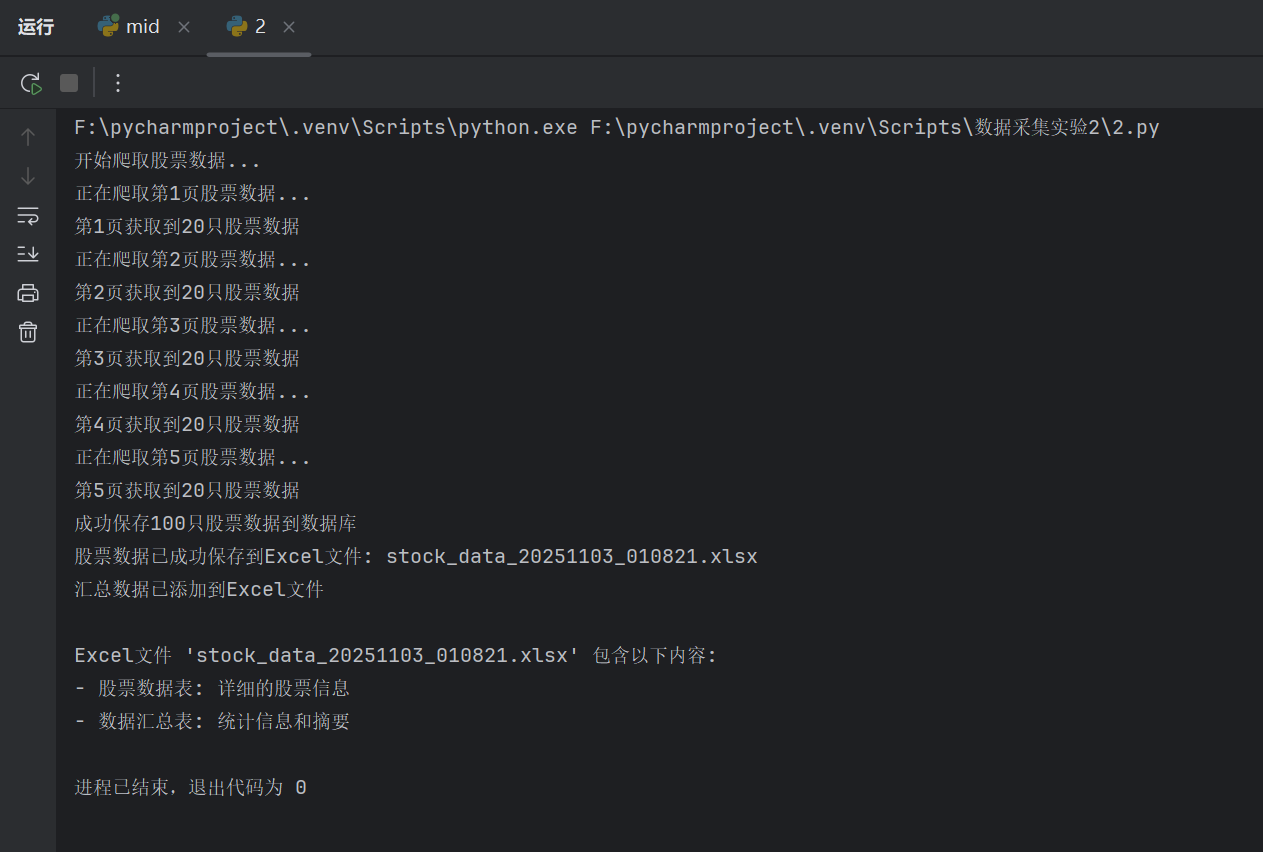



2)心得体会:通过本次实验,我掌握了用requests和BeautifulSoup结合API抓包的股票数据爬取方法,深刻体会到分析接口参数和数据结构对定向爬取的关键作用,也认识到数据库存储在数据持久化中的实用性。
作业③:
–要求:爬取中国大学2021主榜(https://www.shanghairanking.cn/rankings/bcur/2021)所有院校信息,并存储在数据库中,同时将浏览器F12调试分析的过程录制Gif加入至博客中。
–技巧:分析该网站的发包情况,分析获取数据的api
1)实验代码
import requests
import sqlite3
import pandas as pd
from datetime import datetime
import time
import os
class UniversityRankingSpider:
def __init__(self):
self.headers = {
"User-Agent": "Mozilla/5.0 (Windows NT 10.0; Win64; x64) AppleWebKit/537.36 (KHTML, like Gecko) Chrome/120.0.0.0 Safari/537.36",
"Referer": "https://www.shanghairanking.cn/rankings/bcur/2021",
"Accept": "application/json, text/plain, */*",
}
self.api_url = "https://www.shanghairanking.cn/api/pub/v1/bcur"
self.params = {"bcur_type": 11, "year": 2021}
def create_database(self):
"""创建数据库表结构 - 已修复"""
conn = sqlite3.connect('university_ranking.db')
cursor = conn.cursor()
# 删除已存在的表(确保重新创建)
cursor.execute('DROP TABLE IF EXISTS university_ranking')
# 创建大学排名表 - 包含所有必要字段
cursor.execute('''
CREATE TABLE university_ranking (
id INTEGER PRIMARY KEY AUTOINCREMENT,
ranking INTEGER NOT NULL,
name TEXT NOT NULL,
score REAL,
province TEXT,
category TEXT,
year INTEGER,
crawl_time TEXT,
UNIQUE(ranking, name, year)
)
''')
conn.commit()
conn.close()
print("数据库创建成功")
def fetch_rankings(self):
"""从API获取大学排名数据"""
print("开始从API获取大学排名数据...")
print(f"API地址: {self.api_url}")
print(f"请求参数: {self.params}")
try:
# 发送API请求
response = requests.get(
self.api_url,
params=self.params,
headers=self.headers,
timeout=20
)
response.raise_for_status() # 检查HTTP状态码
print(f"API响应状态: {response.status_code}")
# 解析JSON数据
data = response.json()
print(f"API响应数据结构: {list(data.keys())}")
# 关键数据在 data.rankings
lst = (data.get("data") or {}).get("rankings", [])
print(f"获取到 {len(lst)} 条大学数据")
# 处理数据
rows = []
for it in lst:
rank = it.get("ranking") or it.get("rank")
name = it.get("univNameCn") or it.get("univName")
province = it.get("province") # 省市
utype = it.get("univCategory") # 类型:综合/理工/...
score = it.get("score")
if rank and name:
rows.append({
'ranking': int(rank),
'name': str(name),
'province': str(province or ""),
'category': str(utype or ""),
'score': float(score or 0),
'year': 2021,
'crawl_time': datetime.now().strftime('%Y-%m-%d %H:%M:%S')
})
return rows
except requests.exceptions.RequestException as e:
print(f"网络请求错误: {e}")
return None
except Exception as e:
print(f"数据处理错误: {e}")
return None
def save_to_database(self, universities):
"""保存数据到数据库"""
if not universities:
print("没有数据需要保存")
return 0
conn = sqlite3.connect('university_ranking.db')
cursor = conn.cursor()
success_count = 0
for uni in universities:
try:
cursor.execute('''
INSERT INTO university_ranking
(ranking, name, score, province, category, year, crawl_time)
VALUES (?, ?, ?, ?, ?, ?, ?)
''', (
uni['ranking'],
uni['name'],
uni['score'],
uni['province'],
uni['category'],
uni['year'],
uni['crawl_time']
))
success_count += 1
except Exception as e:
print(f"保存 {uni['name']} 失败: {e}")
conn.commit()
conn.close()
print(f"成功保存 {success_count} 条数据到数据库")
return success_count
def display_table(self, universities, count=30):
"""以表格形式展示数据"""
if not universities:
print("没有数据可以展示")
return None
# 限制显示数量
display_data = universities[:count]
# 创建DataFrame
df = pd.DataFrame(display_data)
df = df[['ranking', 'name', 'score', 'province', 'category']]
# 设置列名
df.columns = ['排名', '学校名称', '总分', '省份', '类型']
# 设置索引从1开始
df.index = range(1, len(df) + 1)
# 设置显示选项
pd.set_option('display.unicode.ambiguous_as_wide', True)
pd.set_option('display.unicode.east_asian_width', True)
pd.set_option('display.width', 120)
pd.set_option('display.max_colwidth', 20)
# 打印表格
print("\n" + "=" * 80)
print("2021年中国大学排名(前30名)")
print("=" * 80)
print(df.to_string(index=True, header=True))
print("=" * 80)
print(f"共显示 {len(display_data)} 所大学数据")
return df
def export_to_excel(self, universities, filename=None):
"""导出数据到Excel - 修复并增强功能"""
if not universities:
print("没有数据可以导出")
return None
if not filename:
filename = f"university_ranking_{datetime.now().strftime('%Y%m%d_%H%M%S')}.xlsx"
try:
# 创建DataFrame
df = pd.DataFrame(universities)
# 选择需要的列并重命名
df = df[['ranking', 'name', 'score', 'province', 'category', 'year', 'crawl_time']]
df.columns = ['排名', '学校名称', '总分', '省份', '类型', '年份', '爬取时间']
# 按排名排序
df = df.sort_values('排名')
# 导出到Excel
df.to_excel(filename, index=False, engine='openpyxl')
# 获取文件绝对路径
abs_path = os.path.abspath(filename)
print(f"✓ 数据已成功导出到Excel文件: {abs_path}")
print(f"✓ 共导出 {len(df)} 条记录")
return abs_path
except ImportError:
print(" 导出失败: 请安装openpyxl库 - pip install openpyxl")
return None
except Exception as e:
print(f" 导出Excel失败: {e}")
return None
def run(self):
"""主运行函数 """
print("=" * 60)
print("中国大学排名爬虫 - 基于API分析")
print("=" * 60)
# 创建数据库
self.create_database()
# 获取数据
universities = self.fetch_rankings()
if universities:
print(f"\n成功获取 {len(universities)} 所大学数据")
# 保存到数据库
saved_count = self.save_to_database(universities)
# 显示表格
self.display_table(universities, 30)
# 导出到Excel - 这是新增的关键调用
excel_file = self.export_to_excel(universities)
if excel_file:
print(f"\n🎉 所有操作完成!")
print(f" - 数据库: university_ranking.db")
print(f" - Excel文件: {excel_file}")
print(f" - 总记录数: {len(universities)} 条")
else:
print("\n 数据保存到数据库成功,但Excel导出失败")
else:
print("未能获取大学排名数据")
# 运行爬虫
if __name__ == "__main__":
spider = UniversityRankingSpider()
spider.run()
运行结果:
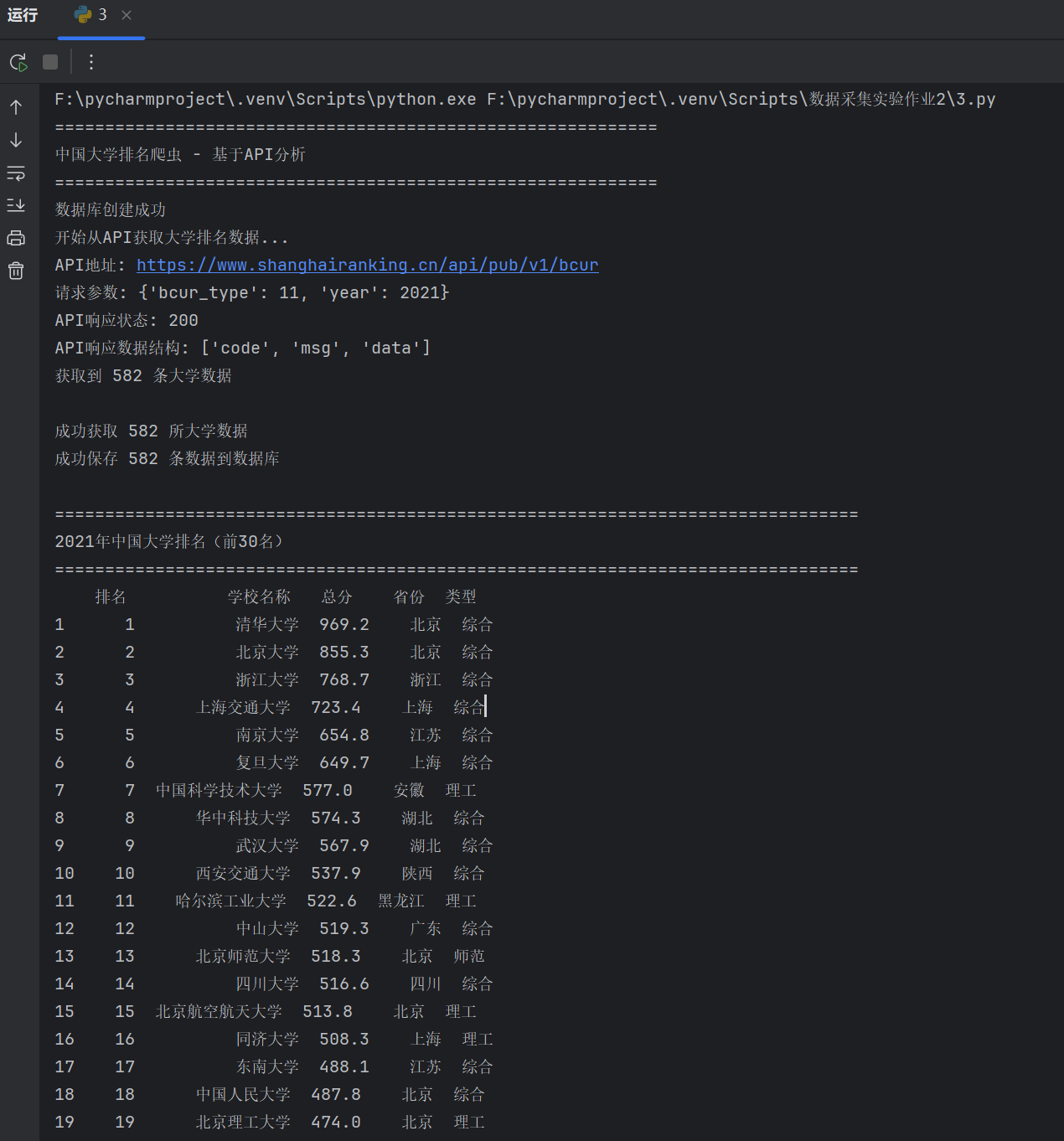
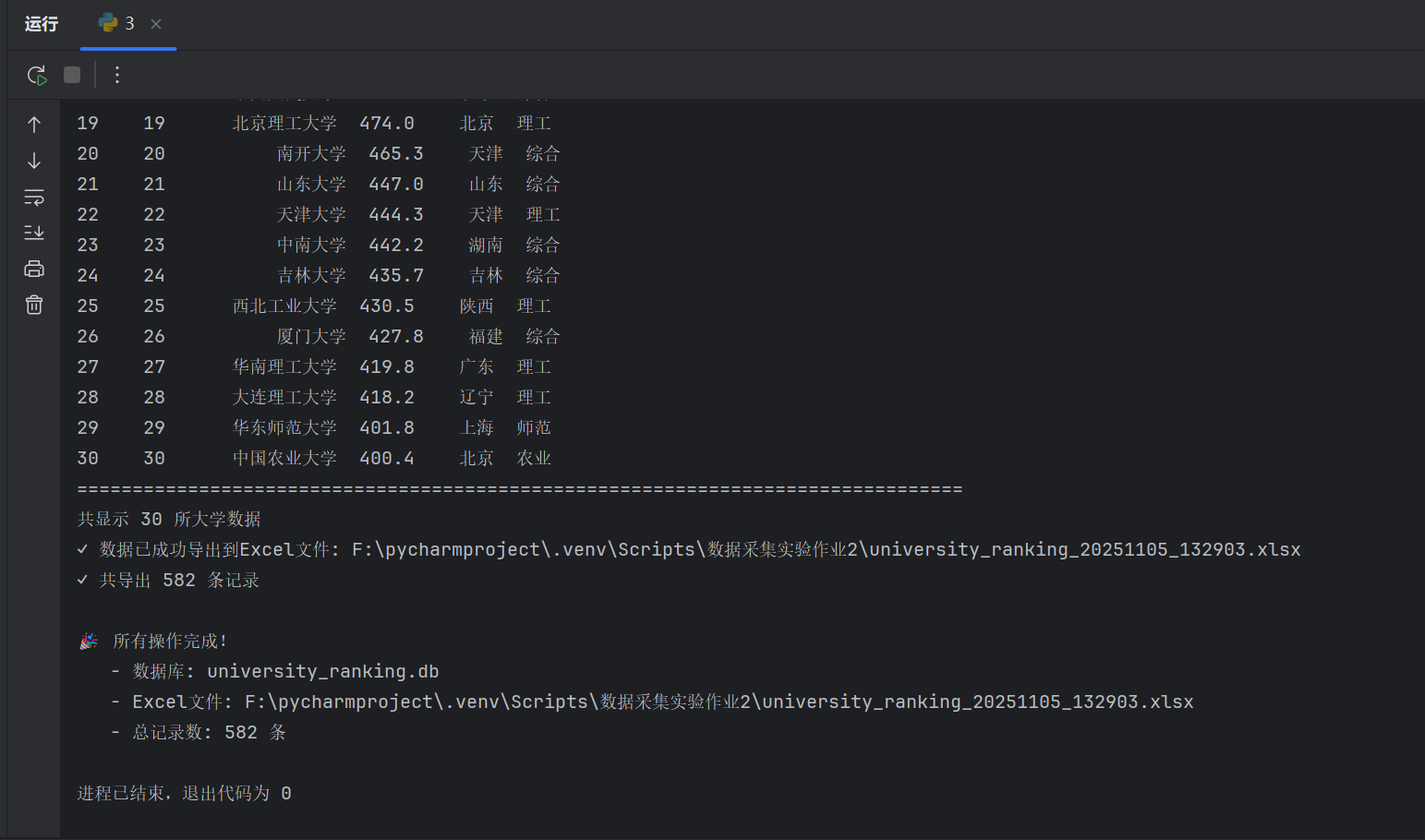
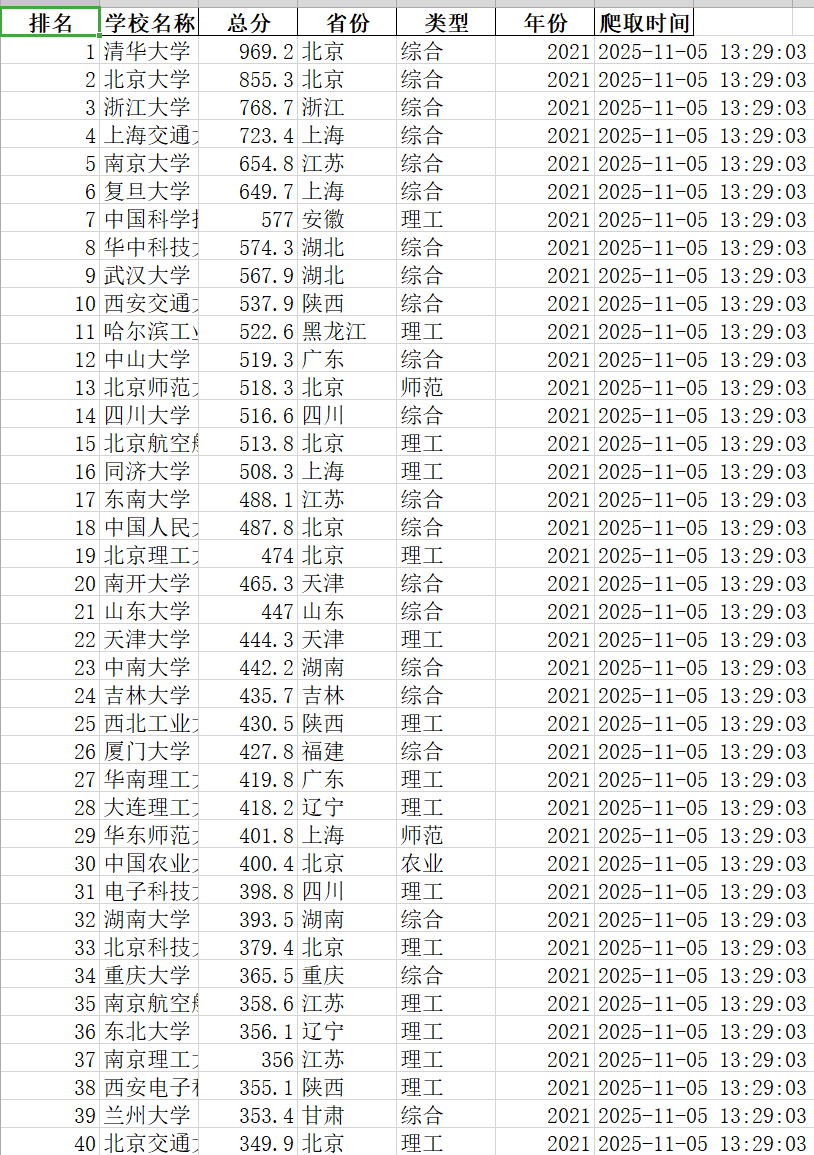
……
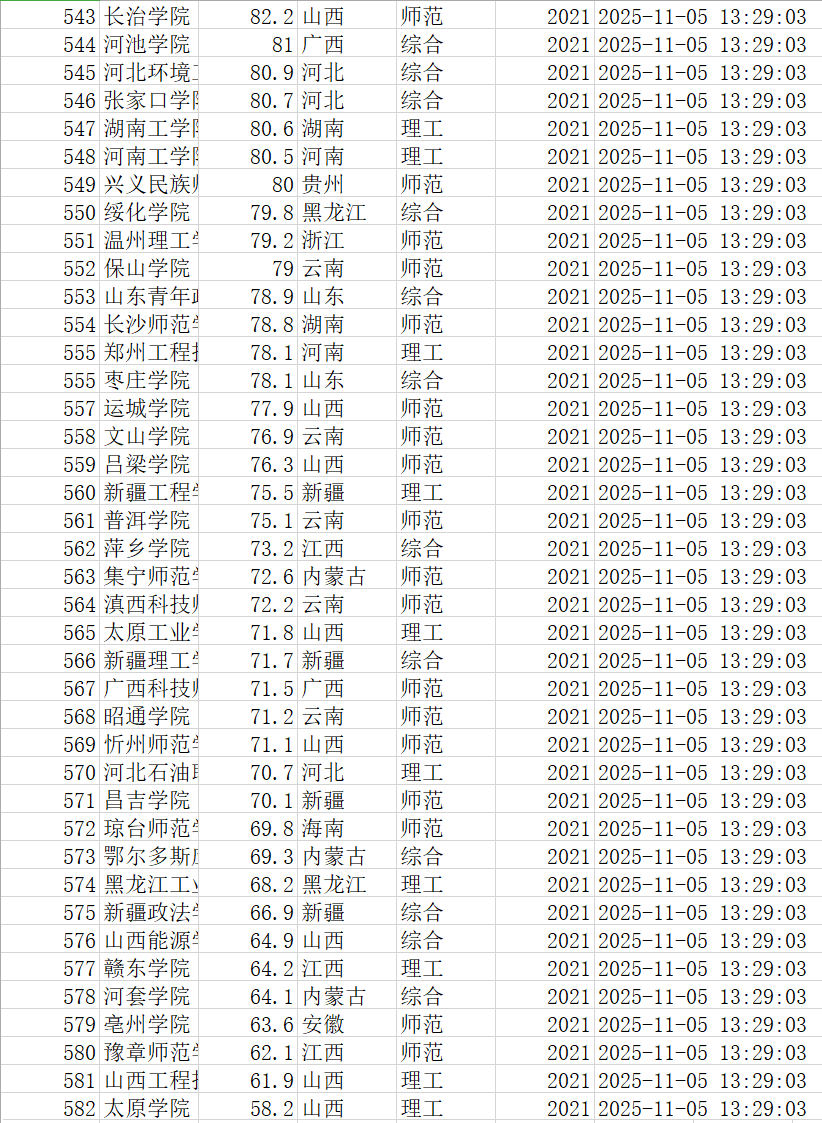

2)心得体会
通过这个大学排名爬虫项目,我深刻体会到数据爬取中API接口分析和JSON解析的重要性。在处理数据库存储时,我学会了表结构设计必须与数据字段严格匹配的关键细节。最终成功实现数据持久化到SQLite和Excel,提升了我的数据处理和错误调试能力。



 浙公网安备 33010602011771号
浙公网安备 33010602011771号